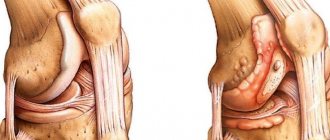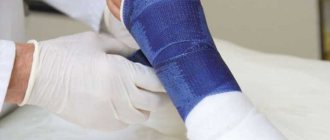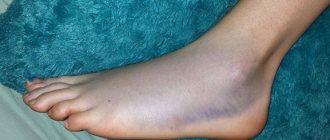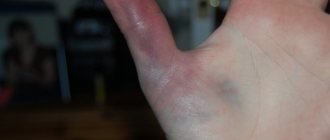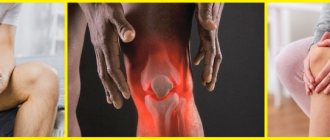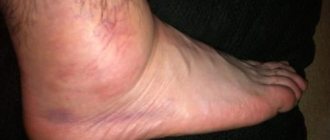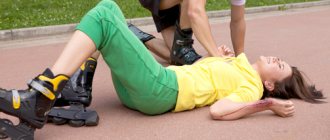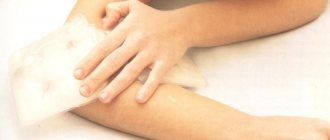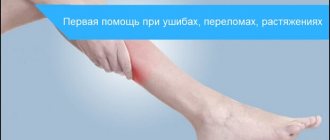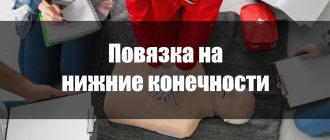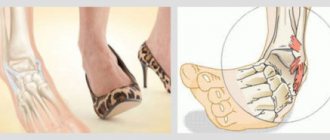The concepts “broke my back”, “broke my back” are more commonly used among the common people. From a medical point of view, this condition is characterized by acute pain in the back that occurs or worsens in response to physical activity. As a rule, this is a signal from the body in response to inflammatory processes and traumatic injuries.
Acute, piercing pain, which often occurs when the back is broken in the lower back, does not allow you to move, do everyday work, and causes a lot of discomfort. Therefore, it is important to know why this pathological condition may occur, which doctor you should contact for help, and what can be done at home before consulting a specialist.
Causes
“Torn back” means a generalized concept that includes various traumatic injuries and pathological conditions of the spinal column itself, the muscular corset, ligaments, and nerve endings. They occur in response to significant physical exertion during sports training or during physical work.
Lifting or moving loads, strength sports, and working in a constantly bent position can affect the occurrence of back strain. Of great importance is how warm the muscles are before physical activity, whether the movements are performed abruptly, and what position the spine is in (the angle of its extension).
Important! A breakdown of the back, in addition to significant physical exertion, is facilitated by a violation of the psychological state, the presence of neurological pathologies and concomitant diseases (for example, ARVI).
The most harmless condition that can be called a back injury is a muscle strain. This is an easily removable pathology. It is enough to use warming and pain-relieving local preparations (ointment, gel, cream), dry heat, and limit physical activity. Also, the generalized concept of a “broken back” may include subluxation, rupture or tear of the lumbar ligaments. These are more complex pathologies, which are accompanied by sharp piercing pain and swelling of the painful area.
The next reason is degenerative-dystrophic processes in the spine (for example, osteochondrosis). Intervertebral discs against the background of the disease lose their original elasticity and become thinner. They are not able to withstand high physical activity.
Quite often, a tear in the lumbar region is characterized by signs of osteochondrosis. This is a dull, chronic pain that gets worse with physical activity, turning, bending or sudden movements. More serious pathologies, which are characterized by severe back pain, may be accompanied by impaired motor functions, numbness of the extremities, are displaced intervertebral discs and hernias.
When lifting heavy objects, it is important to follow a number of rules that will protect the spine and other anatomical structures from damage.
Hernias compress soft tissue structures, which causes swelling, and compress nerve endings, which leads to disruption of innervation and inflammation. Blood vessels are also pressed, which is manifested by hypoxia and compression. Treatment of this pathology already requires an integrated approach, combining the use of medications, physical therapy, massage, physiotherapy, etc. Another reason is vertebral instability. Lifting weights and sharp turns provoke their displacement, which requires not only conservative intervention, but also surgical treatment.
More often than not, men complain about having a “strained” back. However, this problem can also occur in women:
- during pregnancy, when the load on the spine increases several times;
- if you have large breasts;
- while picking up an already grown child;
- with frequent walking in heels.
No ads 1
What does it mean to overstrain yourself?
The spine is surrounded by a muscular corset and cartilage tissue. When axial loads are applied to the spine, it bends due to stretching of the vertebrae. When the load disappears, the vertebrae immediately fall into place. Incorrect or sudden lifting of loads can lead to the fact that the muscles cannot provide the necessary shock absorption to the spine and the vertebrae do not return to their place. They compress the cartilage discs and pinch the nerve roots.
When a person strains his back, muscles are stretched and nerve endings are pinched. This provokes acute pain in the back, or lumbago.
A back injury can be caused by heavy lifting or sudden lifting of objects. People suffering from osteochondrosis are especially at risk. You need to lift loads correctly - straighten your spine, bend your lower back, place the load closer to the body. If you lift objects slowly in this position, injuries are practically eliminated. When performing exercises during training, cases of back muscle strain are often observed. Especially if you train on your own. Therefore, it is better to exercise under the guidance of a personal trainer, who will help distribute the load in accordance with the level of physical fitness.
In medicine, of course, there is no such thing as tearing your back. This phenomenon is called myalgia (translated from Greek as muscle pain). This term means muscle pain resulting from hypertonicity of muscle cells.
ICD 10 code
All diseases are recorded in an international regulatory document under a numerical code - the International Classification of Diseases, or ICD-10. The purpose of this document is to analyze data on morbidity and mortality in all countries of the world, by coding diagnoses into alphanumeric codes. A back strain is identified as a sprained spinal muscle:
- M79.1 Myalgia;
- M79.9 Disease of soft tissue, unspecified;
- M00-M99 Diseases of the musculoskeletal system and connective tissue;
- M65-M68 Lesions of synovial membranes and tendons;
- M70 Diseases of soft tissues associated with stress, overload and pressure.
Symptoms
Most often, such patients complain that they have lower back pain. This is the most common sign of a pathological condition. To understand whether the pain syndrome is a manifestation of more serious diseases, the doctor must determine the location of the pain, the intensity, and what factors the patient himself associates its occurrence with.
The main signs of a back injury:
What to do if you have lower back pain
- Sharp piercing pain radiating to the buttocks and lower extremities, which intensifies after physical activity and decreases at rest. Or, on the contrary, it gradually increases after physical activity and becomes constant, aching.
- A feeling of spasm and tension in the back muscles, which makes the patient's movements limited.
- Nagging pain and discomfort in all the muscles of the back that occurs after straightening it. Sometimes the patient cannot straighten his back completely.
- Visualization of changes in the anatomical location of spinal structures (against the background of vertebral displacement, hernia).
- Numbness, heaviness, tingling in the lower back.
- A crawling sensation, numbness in the toes, weakness, a feeling of coldness in the lower extremities.
- A severe form of pathology may be accompanied by disturbances in the act of defecation and urination.
Poses that will help reduce pain.
If one of your friends or relatives has “broken their back,” the first thing to do is to relieve the spine as much as possible. This can be achieved while lying down, taking the appropriate position. Typically, for lumbar pain localization, this position is lying on your back with hard pillows placed under your shins. Sometimes it is more convenient to lie on your side with your knees bent and a small pillow placed between them.
Severity
The intensity and duration of the pain syndrome indicates the severity of the pathological condition. Mild pain and slight discomfort, lasting up to 2 days, indicate a mild degree of back injury. Moderate severity is manifested by significant pain, spasms, and stiffness. Symptoms last for up to 2 days or more.
Acute pain piercing the back, which prevents a person from moving, means that the condition is severe. In this case, stopping the pathological process and recovery will take more time and effort from the patient. Local medications are not enough; complex treatment is required.
No ads 2
Treatment of back and lower back pain in men
Drug treatment
The basis of drug treatment for back pain is analgesics (most often non-steroidal anti-inflammatory drugs that block inflammatory processes) that relieve pain and inflammation. It is important to know that taking painkillers is symptomatic therapy. Analgesics relieve pain, but do not eliminate its cause. Therefore, they must be supplemented with drugs to improve microcirculation (improve nutrition and metabolism), chondroprotectors (protect cartilage from destruction, stimulate its regeneration), muscle relaxants (relieve pathological muscle spasms) and some other drugs.
Shpidonov Gennady Stanislavovich
Neurologist
Rostov State Medical University (neurology)
10 years of experience
First aid
For mild symptoms of back pain, it is better to go to the doctor immediately. The specialist will select local preparations (ointment, gel, cream) that can be used at home, and explain what mode of activity must be followed. In case of severe pain, before contacting a doctor, the patient must be given first aid to alleviate his condition.
- Place on a hard surface, ensure rest, limit physical activity.
- Place a small cushion under the lower back, which would ensure the presence of a physiological bend in this area.
- Apply cold to the painful area.
- It is better not to use painkillers so as not to erase the clinical picture.
- Monitor your general health, and if your condition worsens, call an ambulance.
The appearance of severe back pain during pregnancy is a reason to urgently consult a doctor
Important! It is forbidden to massage or heat the area of pain in the first few days. This may make the situation worse. You should not self-medicate.
If the pain is very severe.
If the pain is so severe that it is impossible to straighten your back. It is not relieved by any painkillers and sends jabs to the legs. Walking causes the pain to worsen. If you feel discomfort in your legs in the form of tingling or numbness, you should definitely consult a doctor as soon as possible. It is necessary to consult a doctor if an acute pain symptom does not go away within 2 days and radiates to other parts of the body.
Correct diagnosis in this case is simply vital. Because the cause of pain can be not only muscle strain, but also intervertebral hernia, vertebral displacement and lumbar dislocation.
Prohibitions
What to do if you have a back injury is strictly prohibited:
- apply a warm compress or heat the area of pain using special devices (in the first days and without consulting a doctor);
- knead the affected area, massage;
- stretch the spine with exercises without consulting specialists, take yoga poses;
- rub yourself with warming ointments and creams;
- independently adjust vertebrae or any other anatomical defects that can be felt or seen.
[node:field_similarlink]
Diagnostics
A vertebrologist will tell you what to do if you have torn your back. This is a specialist who deals directly with the health and pathologies of the spine. However, you can seek advice from the following specialists: surgeon, traumatologist, neurologist, neurologist, orthopedist, therapist, family doctor. First of all, the doctor will collect an anamnesis, specifying where the pain is localized, what is its intensity and duration, whether it is accompanied by other symptoms (numbness, tingling, burning, etc.), and after which it arose.
In this case, instrumental methods have an advantage in diagnosis. An X-ray of the spine will determine changes in the intervertebral discs, the presence of thinning, and curvature. Magnetic resonance imaging will give a three-dimensional picture, indicating the presence of affected areas in the spinal column, soft tissues, and spinal cord. Allows you to diagnose the presence of protrusion, osteochondrosis, hernia, tumor, etc. MRI can be replaced by CT (computed tomography). This study is more informative than x-rays.
If necessary, ultrasound, thermal imaging, and myelography are prescribed. To confirm inflammatory processes, a general blood test is required, in which leukocytes and ESR will be elevated, and a shift in the leukocyte formula to the left will be observed.
No ads 3
Treatment
Doctors often allow back injuries to be treated at home, as conservative therapy methods are used. Surgical methods are used only for severe pathologies, for example, intervertebral hernias. The patient can usually be cured within 2-3 weeks. The pain can be removed in a few days, but it will still not be possible to quickly restore the body; it will take time.
Medicines
The use of medications is considered mandatory. For milder degrees of disruption, local forms of drugs are used, for more severe ones, combinations with tablet or injectable forms are used. What medications will help get rid of the pathological condition are discussed further in the table.
| Pharmacological group | Impact on the body | Representatives |
| Analgesics | Used to relieve pain. It is recommended to use it first as an injection, then in tablet form. | Tempalgin, Baralgin, Pentalgin |
| NSAIDs (non-steroidal anti-inflammatory drugs) | They relieve inflammatory syndrome, reduce pain, and relieve tissue swelling. Combine a combination of tablets or injections with local forms of drugs | Nimesil, Dicloberl, Voltaren, Ketoprofen |
| Muscle relaxants | Affect muscle tone, used to relieve pain and muscle spasms | Mydocalm, Isoprotan, Baclofen |
| Chondroprotectors | Slows down the development of degenerative-dystrophic changes in the spine, promotes the restoration of intervertebral discs | Teraflex, Structum, Chondroxide |
| Vitamins | Strengthens the body's defenses and promotes speedy recovery | Duovit, Pikovit, Neurovitan |
What to apply to your back if it’s “broken”:
- Diclofenac;
- Apizartron;
- Menovazin;
- Capsicam;
- Fastum gel;
- Finalgon et al.
Important! For severe pain, specialists perform novocaine/lidocaine blockades. Such procedures are not performed at home. Only in outpatient or inpatient settings.
Physiotherapy
These methods of conservative treatment are recommended to be used already during the period of recovery of the body, when the pain syndrome is relieved and the inflammatory process is eliminated. The following measures are considered effective. Massage – helps activate metabolic processes, improve blood circulation, and restore muscle tone. Warming up – maintains the elasticity and tone of the muscle corset, activates metabolism and blood circulation in the tissues.
Therapeutic exercise is a special set of exercises, in this case aimed at supporting the health of the muscles and spine. Performing such exercises allows you to strengthen the support of the spinal column, eliminate spasms and tightness. Experts also recommend stretching before significant physical activity in order to prepare and “warm up” your back and lower back.
Other effective methods of physiotherapy: shock wave, laser, acupuncture, manual therapy, paraffin therapy. Thanks to these procedures, you can eliminate discomfort and spasms, restore local metabolism, and activate blood circulation. Swimming will also be useful during the recovery period.
Folk remedies
The use of traditional medicine recipes is allowed only during the period of remission and under the supervision of a doctor. What you can do if you strain your back:
- Clay with vinegar. In a ceramic bowl, combine 100 g of clay (blue/green) with 600 ml of vinegar (apple/wine). Heat slightly until the mixture is warm. Apply to the area where the back is torn off, cover with cling film, then with a thick layer of cotton wool and wrap with a scarf. After 1 hour, remove and rinse the mixture with warm water. Cover the painful area again. Can be done up to 3 times a day for 14 days.
- Mustard with salt. Combine mustard powder with table salt (0.1 kg of each), add 50 ml of kerosene, stir to a paste. If the mixture is thick, add a little more kerosene. Rub your back.
- Mustard plasters + honey. Apply liquid honey to the affected area, cover with dry wipes. Soak mustard plasters in hot water and place on top of napkins. Make sure it's not hot! After 1 hour, remove, wipe your back with warm water, and wrap with a scarf.
Preventive actions
Each person is recommended to follow a number of simple rules that will reduce risks.
- If you have a sedentary job, you need to choose the right chair that will support your back;
- Watch your posture;
- Get rid of excess weight;
- Eat foods rich in calcium and magnesium;
- Avoid carrying a bag on one shoulder; it is better to choose a backpack;
- Engage in gentle sports: gymnastics, yoga, Pilates, swimming;
- Before physical activity, be sure to warm up;
- Do not move or carry heavy things or furniture alone - it is better to ask for help.
For sleeping, it is recommended to choose an orthopedic mattress.
The basis for preventing lower back breakdown is a good muscular frame.
To form it, it is important to exercise regularly and perform physical therapy exercises. You can use a special exercise machine that will help strengthen your back quickly.
If you have already torn your back once, this is a signal that muscle strengthening is necessary.
Tips on how not to break your back
Tip #1
You should learn how to lift weights correctly: bend your knees, and not put the entire load on your back muscles, hold the object closer to your body, and not on outstretched arms. With a load in your hands, avoid sudden movements and twisting turns. Avoid lifting weights while sitting on a chair. Loads that are known to be unbearable should be discarded.
Tip #2
Before physical activity, do a light warm-up/stretch. Prepared and “warmed up” muscles will become more elastic. This will reduce the likelihood of your back slipping.
Tip #3
Before lifting weights, you should wear a support belt that will fix the muscles in the correct position. During the cold season, you can use warming belts.
Prevention
Preventive measures aimed at strengthening the back muscles will help prevent spinal injuries. The basic rules of prevention include:
- Warm up before training.
- Before lifting weights, you should not overestimate the physical capabilities of the body.
- Active lifestyle.
- Reducing excess body weight.
- Control your posture.
- Regular exercise.
- Even distribution of loads on both hands.
Knowledge of how not to break your back will help you avoid spinal injuries.
Stretching exercises
There are a sufficient number of useful videos and photos on how to restore your back. If there are no contraindications to performing strengthening exercises, it is recommended to regularly perform muscle stretching exercises.
Execution rules:
- Place your hands shoulder-width apart and grasp the bar.
- Suspend completely and relax your back.
- Feet should not touch the surface.
Exercise “Cat” stretches the back muscles well
Execution rules:
- Get on all fours.
- Point your fingers forward.
- Arms should be straight, legs bent at an angle of 90 degrees.
- As you exhale, lower your head down, bend your back as much as possible.
- While inhaling, return to the starting position.
- Bend your lower back down, lift your head and pelvis up.
Perform the exercise up to 10 repetitions.
Answers to frequently asked questions
Question No. 1. Do you always need to treat your back if it’s broken, or can the pain go away on its own?
Painful sensations can indeed disappear on their own after a few days, especially if the back injury is caused by harmless reasons and is not accompanied by serious diseases of the spine. But with the slightest provoking factor, the pain will return, even intensify. Therefore, it is worth determining the cause, choosing the right treatment, and then going through a recovery period (massage, physical therapy, swimming) to strengthen the back muscle corset.
Question No. 2. What is better to use for back pain - ointments or tablets?
More often, doctors prescribe combination treatment, that is, a combination of tablet drugs (or injections) with local forms of drugs (ointments, gels). After the severe, piercing pain that is characteristic of a back injury has passed, only ointments can be used.
Question No. 3. Does lower back pain always indicate that your back is “broken”?
Pain syndrome is the main manifestation of the fact that a person has broken his back. However, lower back pain can accompany other diseases, not only of the spine and other structures of the musculoskeletal system, but also of the kidneys, genitals, urinary organs, etc. The reason can only be determined by a qualified specialist.
What is forbidden to do if you have a back injury?
If there is a suspicion of a back injury, it is strictly forbidden to continue training despite the pain syndrome. Also required:
- Lying down and then just sitting for a couple of weeks;
- Avoid any physical activity;
- Wear a special corset for a long time.
The worst medical approach to treating a torn back is to prescribe complete rest. It is this condition that provokes immobilization of the joints, causing muscle atrophy. Problems occur due to the fact that the spinal muscles are not always ready to remain idle for a long time. They should be prepared for work, although they need to rest a little first. It is much more expensive to treat a chronic condition of a torn back than to purchase a subscription to a swimming pool or the Bubnovsky center, visit a specialist in exercise therapy, or independently organize home exercises to strengthen the corset of the spinal column.
